To view this content, you must be a member of the Rose City Review Patreon
Already a qualifying Patreon member? Refresh to access this content.
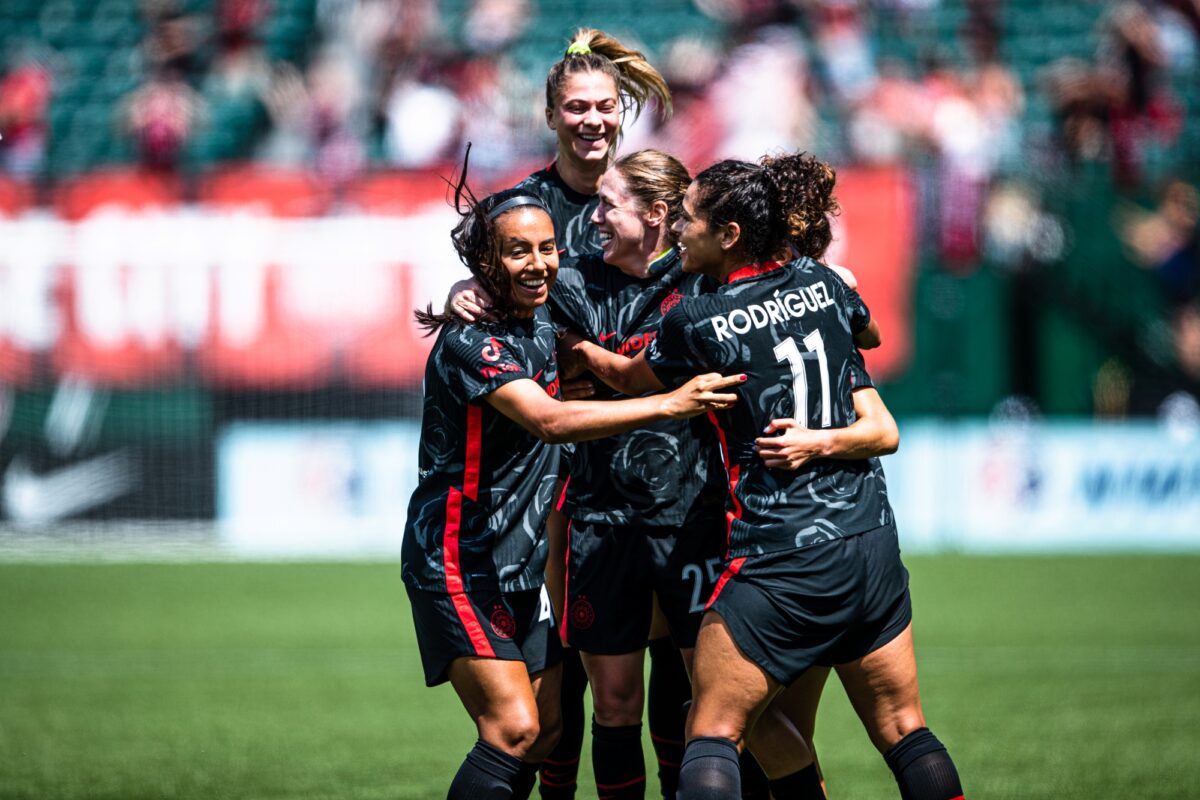

Workers at the Mondelez International bakery in Northeast Portland have been striking August 10 due to a contract dispute with their employer, which wants a contract that includes longer shifts, cuts to overtime pay, and higher health insurance premiums. Nabisco/Mondelez employees in Illinois, Georgia, Colorado, and Virginia soon also walked off the job, and the Portland workers have been joined on the picket line by a variety of other unions, including longshoremen, railroad workers, machinists, and painters.
Today, they added one more union to that list: the NWSL Players’ Association.
A group of Thorns players, including Emily Menges, Marissa Everett, Morgan Weaver, Madison Pogarch, Simone Charley, Bella Bixby, Christen Westphal, Abby Smith, Yazmeen Ryan, and Taylor Porter, picketed in solidarity with the bakery workers along NE Columbia Blvd, holding signs reading “solidarity” and “scabs go home,” and chanting slogans like “no justice, no treats!” and “no contract, no snacks, Portland has the bakers’ backs!”

“I just think it’s important that we show up for other members of the community who are fighting the same fight that we’re currently fighting,” said Menges. “We know right from wrong, and this is wrong.”
The union is in talks with management in Baltimore today, their third meeting since May, but the workers’ grievances go back further than that. “The company for a number of years, has been doing everything they can to try to break the union,” said Mike Burlingham, vice president of the Bakery, Confectionery, Tobacco Workers and Grain Millers International Union (BCTGM) Local 364, which represents the workers. “They’re not coming in to negotiate. They’re coming in with their list of demands.”
Burlingham said the company has yet to make any official offers, and has instead tried to negotiate directly with workers, which is illegal in a unionized workplace. They also brought in scabs from out of town to keep the bakery running while the union members strike.
“The company’s proposal is, they want to set up a two-tier medical plan for us, to create divide within the union,” said Burlingham. Essentially, the proposed plan would mean newer employees would pay higher premiums. “That’s called eating our young, and we don’t do that. And the other thing is, they want to move our eight-hour shifts to 12-hour shifts and change the language of how we get paid overtime.”
“Greed is the problem here, with Mondelez,” said Victor Weekes, a retired worker who now acts as a union representative. “And respect. Mondelez don’t respect the people that work.”
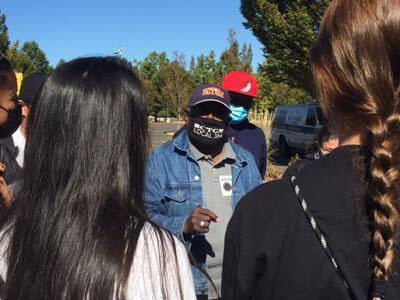
Professional soccer is a very different job from working a factory floor, but workers’ rights are workers’ rights. “I think that we can’t really look at ourselves as like a group of a group of workers that are going through anything new,” said Bixby. “I think that it’s on us to line ourselves up with other workers that are going through labor struggles as well.”
“The details and everything are different—we’re not fighting for pensions, we’re not fighting for that kind of stuff—but just the fair treatment of humans,” said Menges. The NWSLPA is also currently negotiating a collective bargaining agreement with the league, but “for today,” she continued, “we are less focused on what we’re doing and more focused on what they’re trying to accomplish.”
The players’ presence on the picket line was not a Thorns-specific effort, but a gesture on behalf of the whole NWSLPA. “The PA’s been watching what’s been going on with these Nabisco workers pretty much all over the country,” she said. “It just so happened that one of the factories that went on strike is in Portland, and that was the only location that [players] plausibly could have gone to and supported them.”
“I think it’s important that we and other people in the community come and show support, just because I hope that it is taken seriously by their employer,” said Bixby. “I hope that ongoing support by a lot of different groups and a lot of different people helps them take it seriously.”
Seeing the Thorns stand in solidarity with the bakery workers “means the world to me,” said Burlingham. “Them showing up and showing their support is so meaningful to us. Players of that caliber, and the platform that they have and the attention that they can bring to this, it’s phenomenal.”
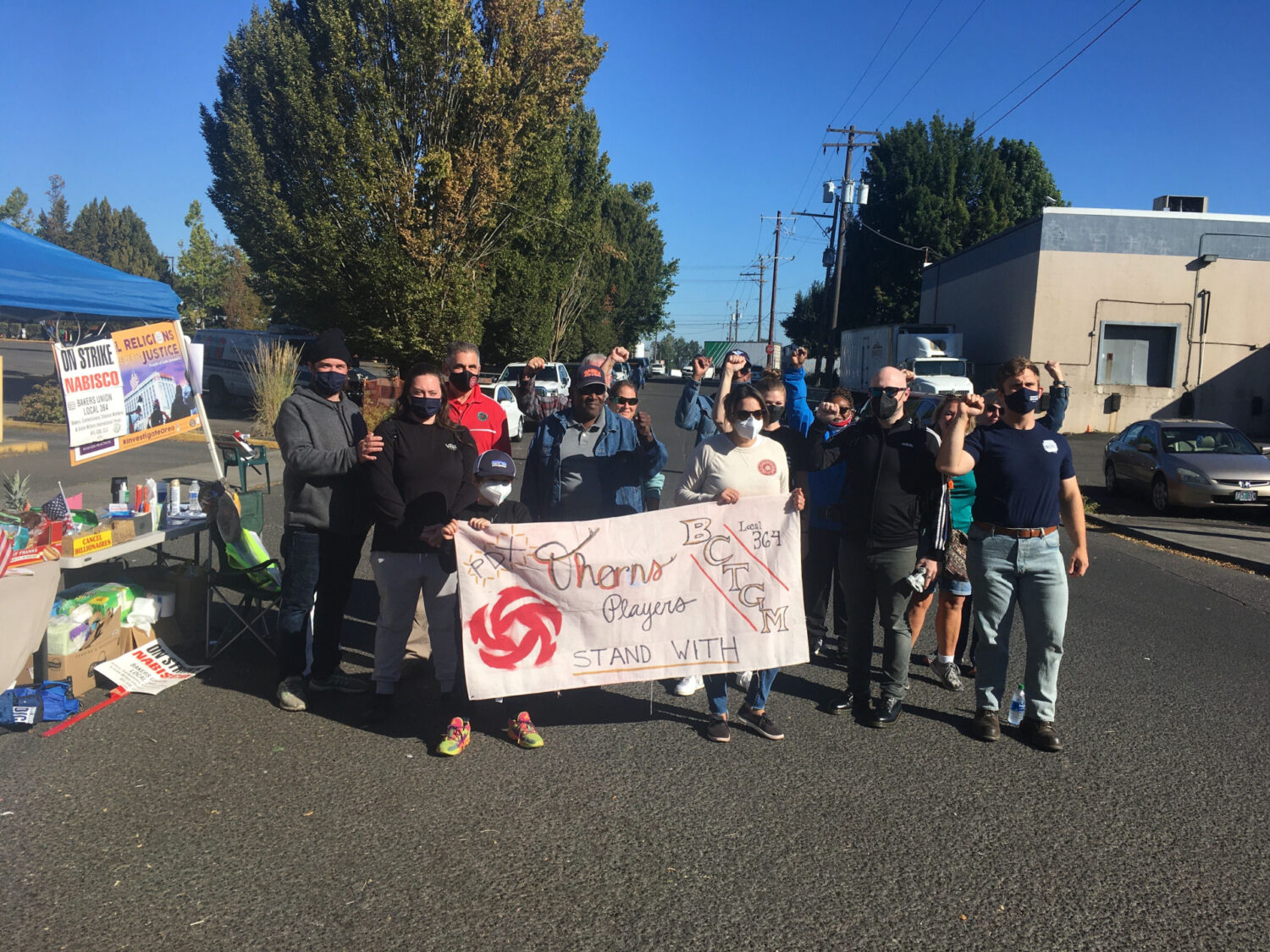
A number of the striking workers are Thorns fans, and several people giddily posed for photos with the players; one woman admitted to me she was too shy to ask for a photo. Weekes is a big Timbers fan, and his son has Thorns season tickets. If the Thorns are in the championship in November, he said with a grin, he’d be there.
All the Nabisco workers I spoke to agreed that spirits are high. “All the support we get,” said Chrysta Knutson, a packing shop steward with Local 364, “it gives me so much motivation and encouragement, and it just keeps my morale up.”
“It takes it takes a whole community, and in this case, an entire nation, because this is a nationwide strike,” said Burlingham. “It’s going to take an entire nation to stand up and say, what’s going on isn’t right… And until that time, boycott Nabisco, boycott Mondelez.”
Some reporting was contributed by Margaret Seiler.

On Friday night, the Portland Thorns posted a video of the incident between Morgan Weaver and Kristen Edmonds with the words “Morgan Weaver is innocent.” Both fans and media called them out, pointing to the fact that framing a white woman as “innocent” in an on-field altercation with a Black woman perpetuates racist stereotypes that frame Black women as aggressors and white women pure and incapable of harm.
The Thorns organization also responded to a tweet from Sarah Gorden, who criticized the initial tweet, saying “the intent of [their] post had an unintended impact.” That’s an acknowledgement that the post caused harm—to whom or how isn’t made clear—but nothing more.
The club deleted the initial post this morning, but has yet to apologize for the language it used.
The intent of the tweet may have been simply to support Weaver as a Thorns player and to dispute the official’s decision, but it became clear shortly after it was posted that the choice of words had an unintended but very real impact on Black players and fans. Language matters, and good intentions don’t absolve us of responsibility.
The Rose City Review is calling on the Thorns organization to issue an apology for the language they used in Friday night’s tweet. Deleting a post after five days of fan pushback—and dismissing those who called it racist during that time—is not good enough. Last summer, when conversations about race in America were in full force, the club repeatedly expressed its commitment to racial justice. The first part of such a commitment always has to be listening to and believing those harmed by racism.
We stand with the Black players, fans, and media of the NWSL and will always strive to hold ourselves accountable to this same standard.

Earlier this week, the PTFC front office released a combined Timbers and Thorns scarf with a heart pattern and the words “here for Portland” on each side. It’s a cute design, and plenty of fans will probably buy it, especially since a portion of proceeds will go to support local small businesses. But the scarf isn’t just PTFC merch—the team designed it in collaboration with the Portland Business Alliance, the powerful business advocacy group whose board of directors is chaired by Timbers President of Business Operations Mike Golub.
As many readers are aware, the PBA has a long history of taking positions on important issues that place it at odds with PTFC’s loudly progressive fanbase. Worse still, some of the causes the PBA has championed directly conflict with the club’s stated values.
The area of most naked hypocrisy when it comes to PTFC’s partnership with the PBA is the issue of climate change. The club lists the environment as a focus area of “Stand Together,” its philanthropic arm. It notes that its “Score a Goal, Plant a Tree” program, a laudable partnership with Friends of Trees, has resulted in the capture of 171,120 pounds of carbon dioxide since 2011. Providence Park’s 2019 expansion received a LEED gold certification. Merritt Paulson has talked about his concern about climate change multiple times, in one tweet calling it “the defining global human issue of our time”—a stance I agree with.
Yet in this context, the club’s public alignment with the PBA is troubling. The business group has historically opposed local and regional legislation aimed at curbing climate change. In 2018, the group sent a letter to a federal regulatory agency indicating their membership’s support for the proposed Jordan Cove liquefied natural gas terminal.
That project, which is still sitting in regulatory purgatory, would involve a “100-foot-wide swath of slashed-and-burned, chemically maintained, plantless dirt (2,000 acres) from Malin to Coos Bay and trespasses over the lands of hundreds of private property owners without their consent,” according to Street Roots. It would also pass under 400 streams and five rivers, using horizontal drilling, a technique that can leach drilling fluids into waterways. The terminal is also located in a liquefaction zone, which will turn into quicksand in the event of a major earthquake; a leak would be enormously destructive to oyster farms and fisheries. And this project is an export terminal, meaning that the gas—produced by hydraulic fracking, which is a nightmare all its own—wouldn’t even be put to use by Oregon businesses.
In 2018, the PBA opposed Measure 26-201, the Portland Clean Energy Initiative, which proposed “a one percent business license surcharge from businesses that make at least $1 billion annually, and use it to fund environmentally friendly projects like weatherizing homes, training people for green jobs, and upping the city’s use of clean energy,” according to the Portland Mercury (the measure passed). The group physically locked its office doors to avoid talking to three faith leaders who wanted to deliver a letter urging them to drop their opposition to the measure, rather absurdly citing staff safety concerns.
And in 2017, the PBA successfully sued the city over a local ordinance restricting the construction of facilities for the transfer or storage of fossil fuels. The city later appealed the decision and won.
If the club has been less vocal about the housing crisis, this is no doubt still an issue of concern for many fans. Portland, like other west coast cities, has a housing shortage of staggering proportions. One study from PSU found that “in a one-year period, nearly 40,000 people in greater Portland experienced an episode of homelessness and 105,000 households faced housing insecurity.” This is Portland’s most visible issue, and its most urgent. It is a human rights disaster, and it should be the shame of every city government for the last 20 years that a solution has not been found. It should also be said that since homelessness affects Black Portlanders disproportionately, this is also a race issue—and the club has made a visible effort on that front.
The PBA, like other Portlanders, professes concern about homelessness, but that concern has generally emphasized the unsightliness of homeless encampments and their supposed impact on business, favoring camp sweeps as part of the solution to homelessness.
In one incident, they pushed the city to crack down on a group serving free meals at Director Park—which they referred to as “feeds” in communications with parks employees—on the basis they did not have a permit to do so.
But most visibly, the PBA runs Clean & Safe, a taxpayer-funded organization that picks up trash downtown and, less innocuously, pays an armed private security force to patrol the area and keep houseless people away from business entrances. Those security guards, according to the Mercury, seem to be completely unaccountable to the public. Even the Portland Police Bureau has a process for reporting officer misconduct; the security staff on Clean & Safe’s payroll are supposedly accountable to the police commissioner (Mayor Ted Wheeler), but an audit “finds no evidence that this has ever happened.”
As the Willamette Week reported earlier this year, even some downtown business owners are unhappy with Clean & Safe. That unhappiness largely stems from the fact that the fees that businesses pay the group go, in part, to pay salaries and overhead for the PBA, not to pay for any actual services.
It’s worth noting that the PBA has, in the past, urged support for more shelter beds. But to people who study the issue, emergency shelters are a stopgap solution, at best, and are often rejected by the people they’re intended to serve for very good reasons.
This is just a cursory look at two of the issues the PBA is most egregiously wrong on. They’ve also opposed a mandate for bike parking in new construction, supported discriminatory sit-lie laws, and voiced weirdly fierce opposition to the Better Naito project, and are generally anti-tax, even opposing taxes that Portlanders have voted for in order to fund needed services.
In short, this is a group concerned with the bottom line of their members above all else. To me, that’s at odds with the way PTFC has positioned itself over the years, and with much of the truly commendable work the club has done in the community. Fans on Twitter were upset about this announcement, and I believe that anger is justified. If the club professes to be a community-centered organization, this partnership calls that into serious question.
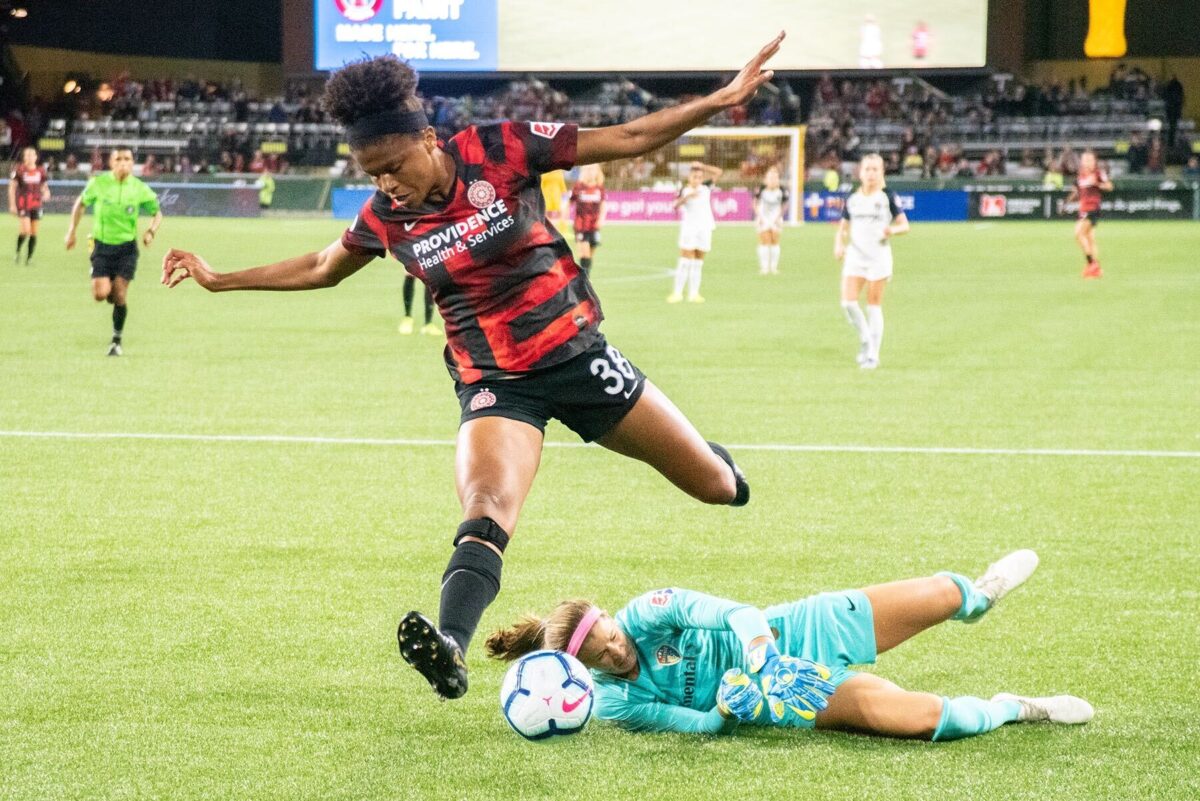
Well, you saw the title of this post. Let’s not waste any time gabbing away, hm?
This one is good because Meaghan Nally’s friends and family get to enjoy her radiant smile, and also her enemies can see how strong and healthy her teeth are to know she will not be easily defeated.
https://t.co/IIng1nVeK8 pic.twitter.com/ZOfAfsa1wJ
— Portland Thorns FC (@ThornsFC) March 20, 2021
You’re in the front row at a One Direction concert, and Harry Styles points right at you.
👉 @ADizzle23 👈 pic.twitter.com/wVgai8rlT6
— Portland Thorns FC (@ThornsFC) March 19, 2021
Four women who went to Harvard Law are starting a boutique firm together. The office is a casual environment—one of them even brings her dog to work—and they do lots of pro-bono work for low-SES and undocumented clients. “We’re sort of like a family,” they say.
🥺 wholesome 🥺 pic.twitter.com/itCE7dcXMM
— Portland Thorns FC (@ThornsFC) March 19, 2021
A true story about me is that one time Nadine Angerer called me a “soft egg,” which I guess means I’m squishy and delicate? It wasn’t an insult, but it also wasn’t a compliment. It was just an observation, like everything Germans say. Then she laughed good naturedly like this:
https://t.co/EQoOQmCjet pic.twitter.com/sZDDp9da1t
— Portland Thorns FC (@ThornsFC) March 20, 2021
The most popular girl in school asks you to prom. She could have gone with anyone, but she chose you, the eccentric loner who eats lunch in the library and listens to bands no one else has heard of. You’re so different from everyone else, and she just wants to get to know you.
https://t.co/gVttSKWeOA pic.twitter.com/uitOzgEYeS
— Portland Thorns FC (@ThornsFC) March 20, 2021
The girl who sits next to you in pre-calc asks you to prom. Your only real interactions are checking your homework together and passing notes about substitute teachers. She knows you don’t know each other very well but she thinks you’re really funny and thought it might be fun to hang out for the night? She really hopes this isn’t weird.
😃 @nataliakuikka 🌹 pic.twitter.com/MYVW4gAZbO
— Portland Thorns FC (@ThornsFC) March 19, 2021
I like this photo because Crystal Dunn is being very clear about what club she plays for.
https://t.co/BKXBgyXC3F pic.twitter.com/CWVoQkrTPv
— Portland Thorns FC (@ThornsFC) March 20, 2021
You’re sixteen years old and you just read one of your poems at an open mic night for the first time. Your big sister is going to college an hour away, and you invited her, but you weren’t sure if she’d come—but she did, and she’s so proud of you.
😏 @raque_rocky 🥰 pic.twitter.com/Onps0a7TPx
— Portland Thorns FC (@ThornsFC) March 19, 2021
This season on The Bachelorette:
🌹 @asalem6 🔥 pic.twitter.com/QIkzsKsbWF
— Portland Thorns FC (@ThornsFC) March 19, 2021
She is the captain of this battle station and she will gladly crash it into Alpha Centauri before she gives an inch to the insurgent scum, damn it!
🖤@beckysauerbrunn ❤️ pic.twitter.com/AnjDvWMXAj
— Portland Thorns FC (@ThornsFC) March 19, 2021
Oh, hello. Surprised to see me in your chambers? I’ve been waiting for you. That’s right, I know all about what happened to the queen’s prized jewels. The captain of the guard awaits only my command. You won’t last long in Her Majesty’s dungeon—and just when we were getting to be such good friends! Unless… we can work something out?
👑 @Cdunn19 🌹 pic.twitter.com/XiYjukOJ51
— Portland Thorns FC (@ThornsFC) March 19, 2021
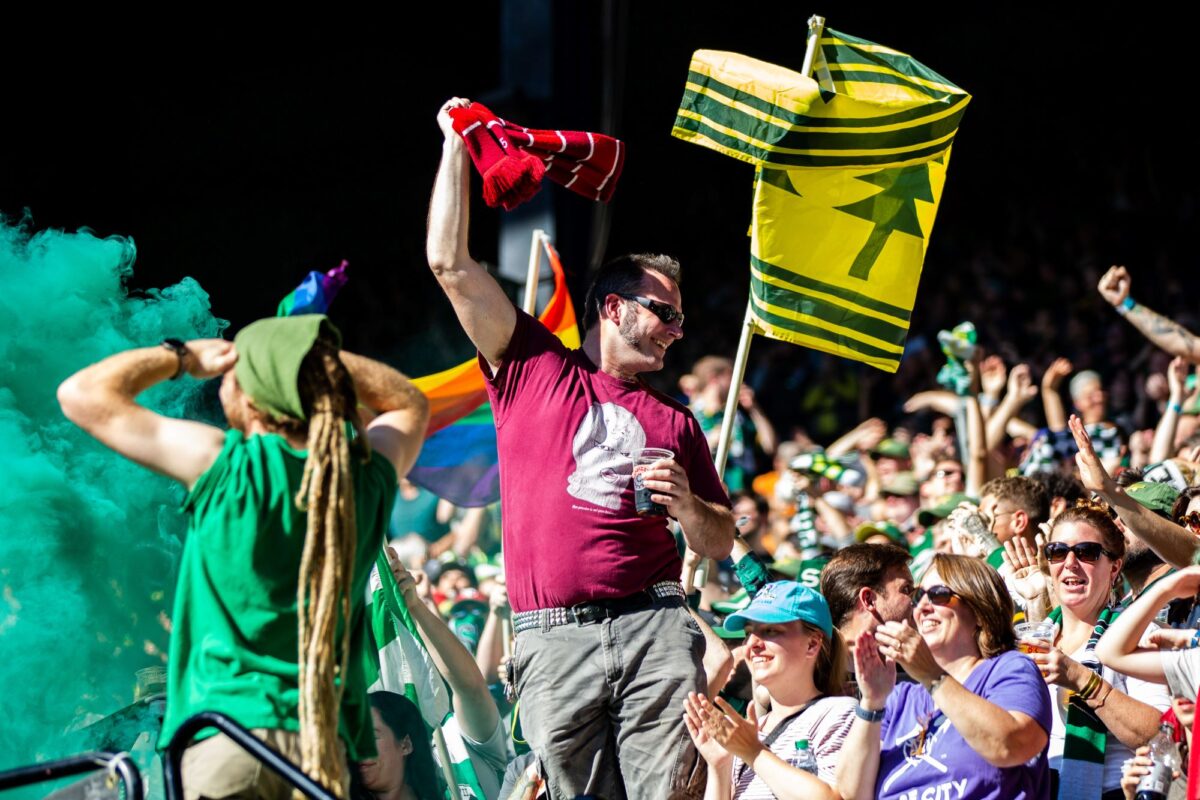
Disclosure: Jennifer Ingraham, a 107ist board member, also serves as a copy editor for Rose City Review. She was not involved in the creation of this piece in any way.
Last summer, a number of Portland soccer fans came forward about their experiences with the 107ist, the organization that coordinates both the Timbers Army and Rose City Riveters. The first was Milo Reed, a Black capo in the TA. In a Medium post, Reed wrote that the 107ist board had repeatedly ignored and spoken over him when he tried to weigh in on a discussion about a blog post some on social media were calling racist.
Following Reed’s post, two members of the 107ist talked with Rose City Review about their own experiences in the TA and RCR. We also spoke with the founders of Black Fires, a Black supporters group in Chicago. All four echoed Reed’s sentiment: self-proclaimed inclusivity and anti-racism isn’t enough if BIPOC don’t feel like their presence and voices are valued.
Fans called on the 107ist board to actively listen to and engage with fans of color, make the structure of the organization more accessible, and for board members to step down and create space for BIPOC to take their place. One person specifically said the board needed at least three BIPOC members before she believed they could move forward. Then-newly named 107ist President Gabby Rosas predicted that those resignations would take place in December 2020, in accordance with the regular 107ist election cycle.
Over the summer, the 107ist also formed a BIPOC committee to provide independent oversight of the 107ist and evaluate why fans of color had the experiences they did. However, all of the BIPOC committee members are also 107ist members—a requirement for any committee position within the organization.
“We were not going to solve the board’s diversity and race problem,” the committee said via email, “but we could, out of love for the community we were part of, help point out areas they needed to address change and to call them out when they failed to meet expectations.”
Since the BIPOC committee formed, it has held regular meetings to discuss race in the TA and the police presence in Providence Park, advocate for better representation within the 107ist board and committees, and create better pathways for the general community to get involved with the 107ist.
When election season came around, three of the current board members—including Rosas—were reelected to three-year terms.
“We’re seeing that as a big red flag,” Rosas said, “because we recognize that as an organization we need to be doing a better job of soliciting for new board members and making sure that everyone who’s interested knows enough about what it is to be on the board and what the organization needs and can feel comfortable running.”
The one new member, who is white, filled the seat of Ray Terrill, who had stepped down over the summer and asked that his position be filled by a person of color.
The 107ist also created a new election pathway that allows for members of the RCR and TA steering committee to each nominate a representative to a one-year term on the board and the BIPOC committee to select two candidates. The TA steering committee and BIPOC committee took advantage of this new pathway and appointed three representatives in total.
“We’re very focused on making sure that we’re listening first,” Rosas said. “And listening to not only our new board members, the two that were nominated by the BIPOC committee, but also that committee as a whole.”
However, Rosas said there’s a learning curve for new members, which makes it hard for new representatives to make an immediate impact. The board is looking to make that transition easier for members who are elected to one-year terms. Rosas specifically pointed to ensuring that one-year representatives have information early and said the board is making an active effort to prioritize those members’ central goals. “It’s creating a sense of urgency that I think we needed,” she said.
The board is also trying to lighten its workload by allocating tasks to its various committees—something that will allow members to spend less time on paperwork and more time on the initiatives they want to carry out—and expanding overall committee membership. Rosas said she hopes this will make board positions more accessible to prospective members, since up to 12 hours of work per week is a lot to ask of a volunteer position.
Rosas said breaking down those barriers and building out all the 107ist committees to encompass a wider range of ages, backgrounds, religions, and cultures can also help inform 107ist practices. “As we diversify all of our committees, we’re able to better understand who we’re representing,” she said.
The BIPOC committee also pointed to the time commitment as a barrier to soliciting engagement. “BIPOC are already carrying the burden of this in our daily personal lives,” it said, in the form of explaining racial bias or navigating systemic racism within work, school, or community spaces.
“We are volunteering our time and knowledge to ensure the 107ist is a more inclusive organization where all members’ voices are heard and respected,” the committee said.
The BIPOC committee said COVID-19 also presents a barrier to outreach; the 107ist, TA, and RCR are primarily united by a love for Portland professional soccer, which makes engagement more difficult when everything is virtual. On top of that, many members generally have less free time, as they’re prioritizing safety and job security during the pandemic.
Still, the committee has created a pathway to anonymously present member grievances to the board by acting as a mediating body. Rosas said the 107ist is getting different feedback now that the BIPOC committee exists, although neither she nor the committee wanted to expand on the specifics of these complaints due to privacy concerns.
The BIPOC committee is also working to create a more formalized grievance process and engage with members. Due to the volunteer nature of 107ist positions, the committee said everything moves a little slower than a regular, paid workplace, but it expects to have more updates later in the year.
When asked about how it is dividing its focus between individual grievances, structural issues, and fostering pathways for representation within the 107ist, the BIPOC committee said it was “an ongoing discussion” and that more information would be available at a later date.
Rosas said trying to enact change while the BIPOC committee is still working to establish itself has added another layer of difficulty to enacting change within the 107ist. “I think what some people were expecting—and some people on the board were expecting—was that the BIPOC committee would just tell us what to do,” she said.
To Rosas, it’s been a balance of ensuring the 107ist is soliciting feedback from those outside the board, including other organizations, and taking responsibility to act on its own. The board recognizes that the autonomy of its position comes with responsibility. “We can’t wait for the BIPOC community, we can’t wait for any underrepresented community to come up with the words to tell us, ‘We’re not represented’,” she said. “We as a board, we as a leadership group have to figure out how we can represent our members without them telling us.”
Currently, the board is focusing on its annual general meeting for members—to be held at the end of February or early March. Rosas said that’s when the 107ist will share more detailed plans for its 2021 initiatives.
“We are not dropping any of our focus from last year,” she said, “but increasing the ways we want to make meaningful impact with our members and in our communities.”
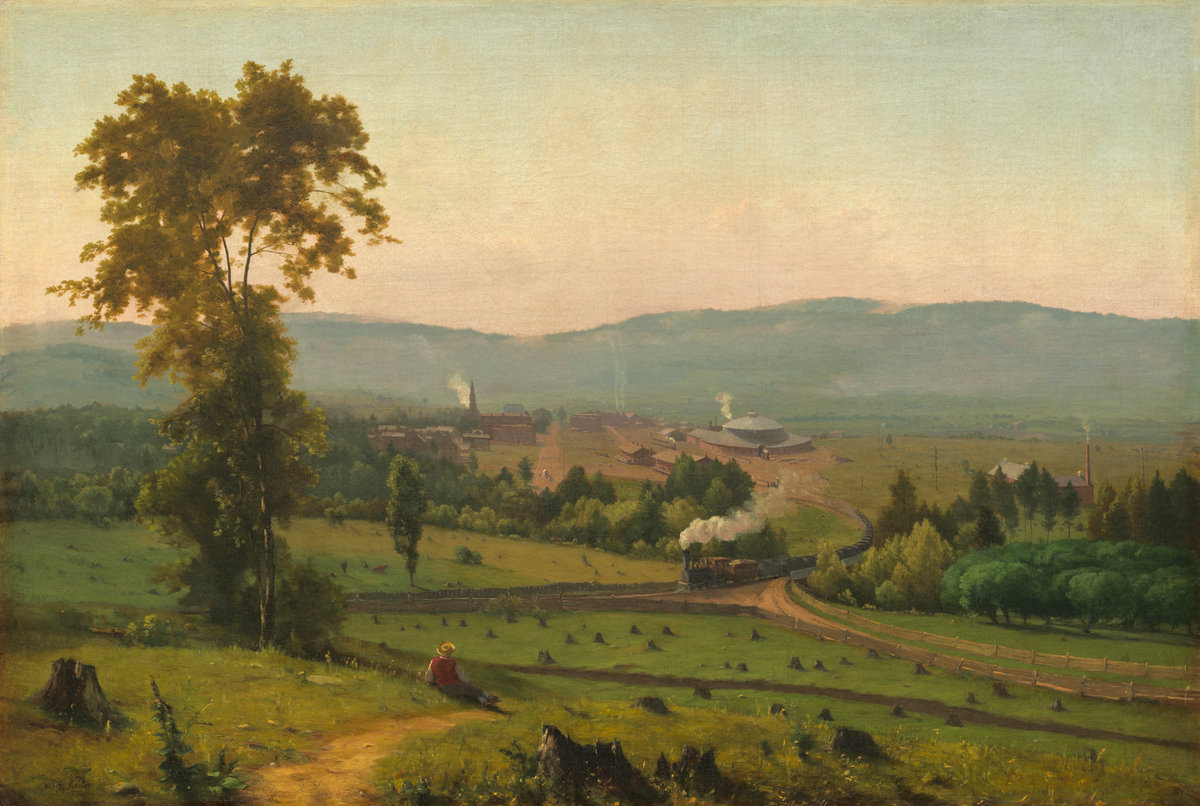
I have wonderfully exciting news to share, which is that I have met a small pig named Hiram. This is Hiram:

I met Hiram because I have been riding a horse named Rusty once a week. I am a former Horse Girl and was introduced to Rusty via my college job board, where her owner was seeking out volunteers to come be friends with her. This is Rusty:

I was riding Rusty in the pasture and suddenly she would not stop staring at something on the other side of the fence. We went over to investigate and the thing she was staring at was a little pig with splotches. She was so enthralled that the ride immediately became over.
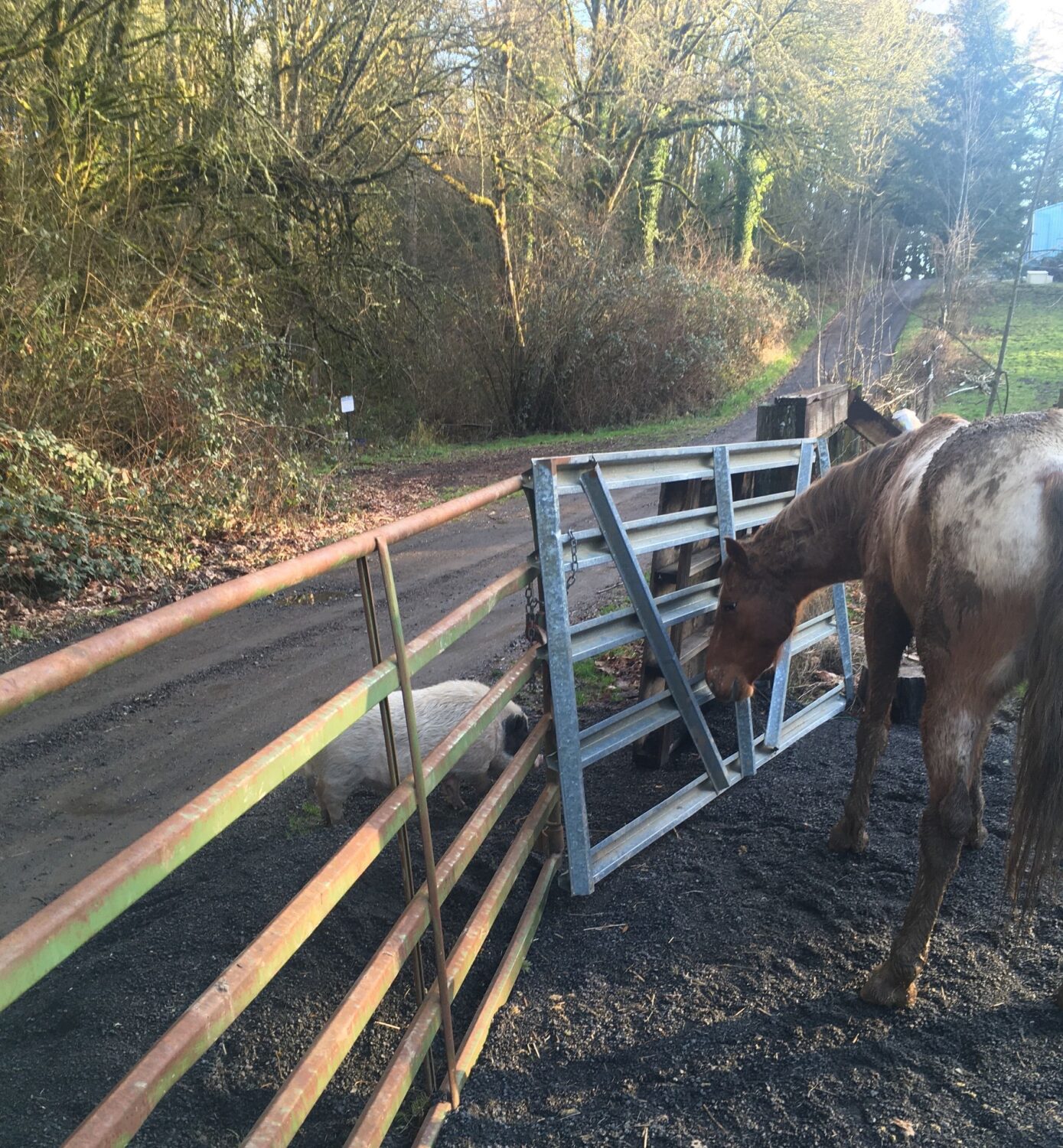
Rusty tried to make friends with Hiram but he was not interested. I wanted to give Hiram some scritches but he was also not interested in those, which I respect. We were lucky simply to be in his presence.
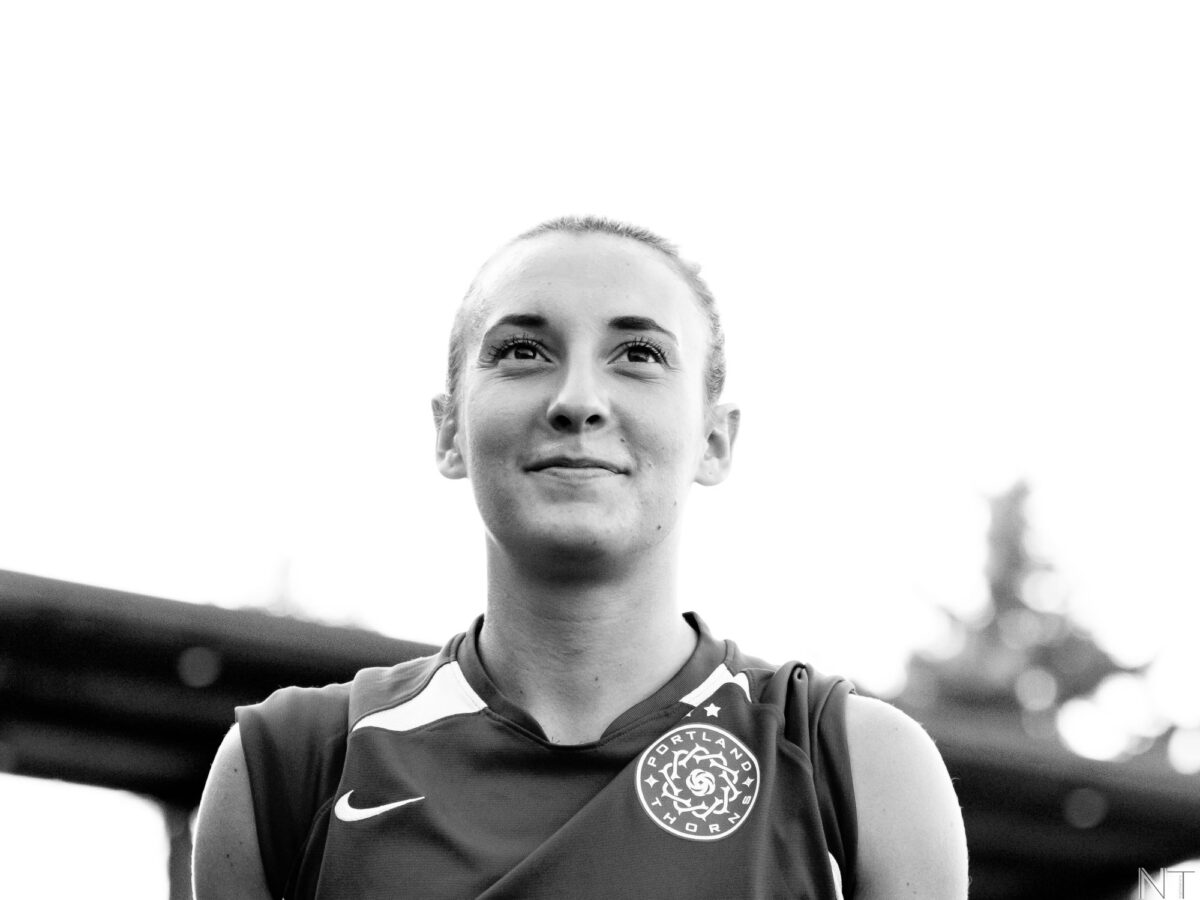
Seattle-based photographer and Rose City Review contributor Nikita Taparia has something in common with Thorns midfielder Gabby Seiler: they’re both huge tennis fans. Taparia sat down (via Zoom) with Seiler for a wide-ranging conversation touching on female athletes, tennis fashion, and the similarities between the two sports. The conversation below has been edited for length and clarity; the full audio is available on our Patreon for $10 subscribers.
Nikita Taparia: What is your tennis origin story? Like, how did you become a fan, and at this point, how hardcore do you think you are?
Gabby Seiler: So, it actually started with my boyfriend. He played tennis at Florida, and I met him at Florida, and I remember going to my first tennis match and being like, what the hell is going on? I knew absolutely nothing, and I never watched tennis growing up. So I went to my boyfriend’s, McClain’s, tennis match at Florida, and I was just like flabbergasted, like I was obsessed. I would go to his tennis tournaments or his matches. I just started to love it, and then I started watching majors.
NT: Do you have a favorite player that you absolutely love watching?
GS: So since I started playing tennis, I think the player that I would like to play like is probably someone who mimics me too, kind of on the soccer field, is [Angie] Kerber.
NT: Ooh, yes!
GS: We have similar body types, and I feel like she’s super powerful, muscular, and she’s super quick, agile, athletic, can kind of cover all the bases on the court. Obviously, I love Serena. I mean, how can you not? She’s an absolute legend and I mean, she’s amazing. Those two are probably my favorite players. Obviously, Osaka is really talented and so fun to watch, and she’s amazing. I feel like there’s just a lot of women that I just love to watch.
NT: I’m right there with you. So of those players and of women’s tennis, if you could take one attribute from them, like strength, or flexibility, or mentality, or endurance, or whatever, and use it towards soccer, what would it be?
GS: Honestly, so I never was the biggest fan of Azarenka—like she’s amazing, but I didn’t really know her that well since I’m new to tennis—so once I knew her background, and hearing her story, I think she has a really cool story. I really like her energy. I think she has this mentality about her, and like, nothing really phases her and she stays really composed. I said that to McClain, and he said, Gabby, you haven’t seen her in previous matches.
NT: Yeah, I feel like there definitely has been an evolution in her game.
GS: And one thing I really like is how calm Osaka is, like even in the final, I was really amazed with her composure, and I think with soccer you need that. And I think, for me, I have a lot of energy, but I think adding that composure and just being able to settle things down, or just like not let things affect you, is really amazing and kind of compartmentalized.
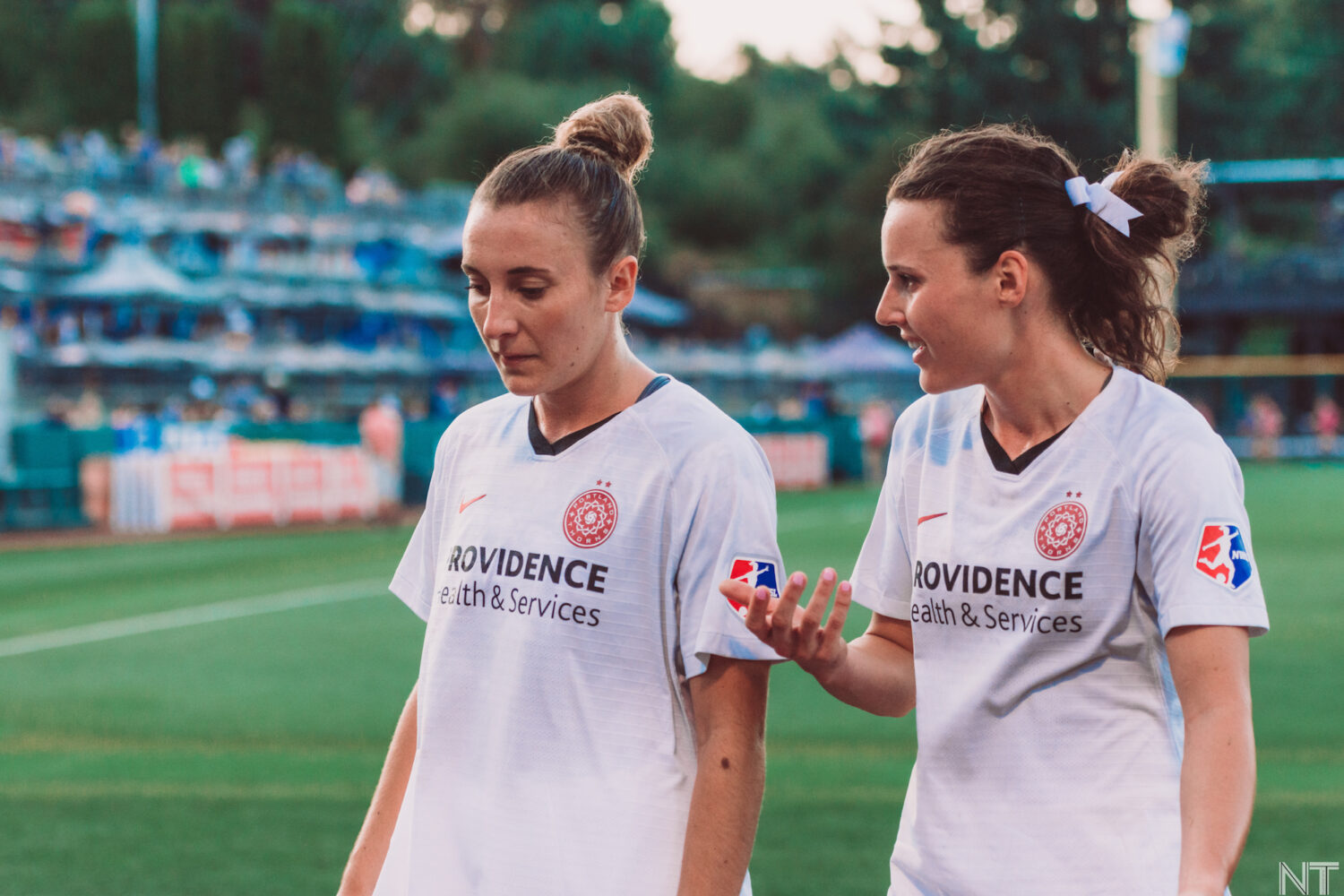
NT: Yeah, we saw that on the women’s side for the US Open, where it was first Vika who was coming back after that first set [against Serena], and then we saw Naomi do literally the same scoreline to Vika, but it was this idea that, I think she literally said, I didn’t want to lose this way. It was like a switch that turned on all of a sudden.
GS: Yeah, and I think that’s so cool, and I really appreciate that. What was cool about Vika is that she went straight to play the next tournament like nothing [happened], and she was absolutely crushing it. I think that’s so cool!
I think I have grown to like her and kind of root for her, just from hearing her story. And I think whenever you hear someone’s background and story, it kind of changes, too. I think that’s the cool thing about tennis in the sense of, it’s not a team sport, so everyone has this really unique story.
NT: You are hitting it right on the nail. I feel like in the beginning, I was pretty equal in my watching of men’s and women’s tennis, but over the years, I have very much gravitated towards women’s tennis because I just love the way all of them play. They all have their different styles, strategies, and whatnot. And I mean, that’s not to say that the men’s side doesn’t have that, but—I don’t know, I just haven’t had as much inspiration.
GS: Yeah, I agree with you, and I think we can kind of relate to them a little bit more. I just have so much respect for them. I have respect, you know, for the fact that they get paid the same and things like that. I just think that’s cool for the women who did that before them, so that they have what they have now. I think for me too, I just relate to their stories, like you said. Not that I don’t really like the men’s—I just feel more connected to it.
And you know, sorry, but females also have babies! So I have a lot of respect for people like Serena, and girls who are moms, and Vika. I think that’s so cool, and I can’t even imagine what’s that like, but even for soccer players who do that, that is actually amazing. And those women are superheroes.
NT: Absolutely. I feel like we’ve been gravitating towards this: on the women’s side of the game, what lessons do you think NWSL can learn from tennis?
GS: Ooh, that’s a good question! I think that something we can learn from tennis is obviously what Billie Jean King did—she took a huge risk, and that’s definitely not easy, and she kept pushing for more and pushing for more. I think like we as women shouldn’t have to do that, but I think we keep having to do the same, whether that’s us supporting the WNBA, or whether that’s the WNBA supporting NWSL.
I just think we have a unique opportunity as females and as athletes to use our platform, and I think even like, what Osaka did in the US Open, I think that’s something we can all continue to learn from. I think that NWSL’s definitely getting there. I know at least on our team, we’re having those conversations and we’re trying to push for more. But I think there’s always room for improvement.
And then secondly, I think we as players, the thing I love about tennis is I feel like all those women are so unique and they use their strengths, and I think sometimes when you’re on a team you can become a little bit monotonous, or kind of be a robot. I think we all have unique abilities, and I think the more that we can bring that to the women’s game and show those unique qualities in games, it’ll make the women’s game more fun.
NT: Yeah, for me that’s a number one thing, and it’s interesting because I think on my side, as a photographer, I start to kind of pick up on habits of players while they’re playing. Like I was having this discussion earlier about how I’ve noticed how players run.
GS: Oh, yeah, I believe it!
NT: Literally how they run. And in terms of, because I photograph it so often, and I edit it so often that I’ve picked up on how they run and when they’ll run where. And I think, again, that uniqueness does come out, but, yeah, I’m all for everybody doing whatever trick shots you want to do, any tricks you want to pull off!
GS: Yes, it’s true! No, I think one thing that I know like, our coaches try to—they want you to do, obviously, what’s best for the team, but we obviously are all here for a unique reason and we all have different strengths, and I think like, you want to try to bring those out too within the team environment. Even today when we were watching the Reign game, when Sofia Huerta let it go through her legs for Bethany [Balcer]. I think the more we can do things like that—because the women’s game is really fun to watch, and I think people don’t realize that, because, one, it’s not on TV, but. I think the more we can do that, the better, and the more people will want to watch.
NT: One aspect that I often think about as a tennis fan, and it’s part of football culture as well, is fashion is a big thing. I’m wondering, are there any particular tennis looks that you’ve started to notice and that you’ve liked?
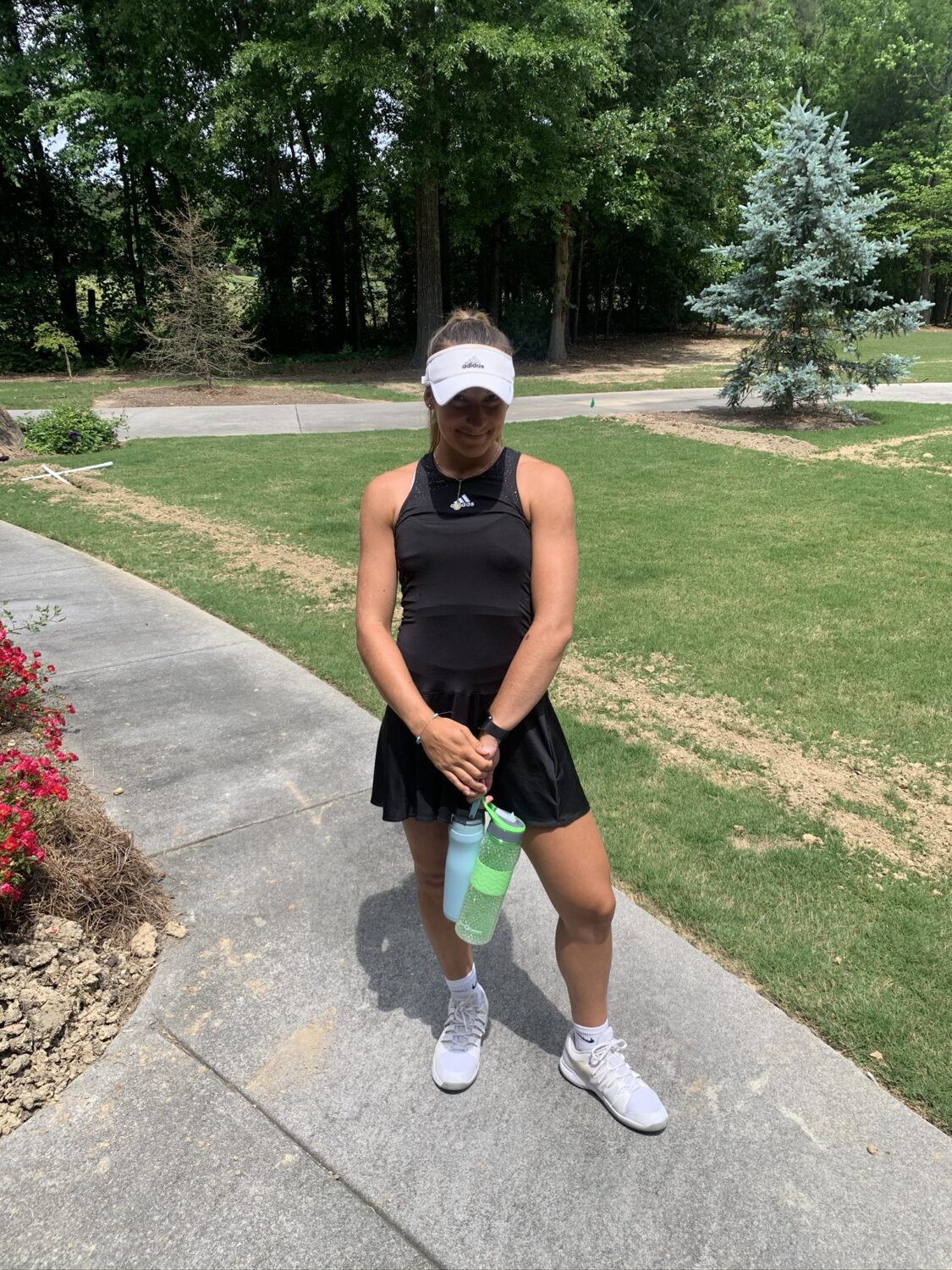
GS: Yeah! I, one, fell in love with tennis because of my boyfriend, but then, the outfits are really what drew me in. Because I love the cute tennis skirt, the cute tennis dress. You know, there’s been some unique ones. The US Open ones, I didn’t particularly love them this year. I think you have to find a balance, but I’m also not into, I know it’s been a tradition and I think it’s kind of cool, but—
NT: The white?
GS: Yes. The whole white thing. I don’t know, I personally like the uniqueness too. But I’m trying to think—I don’t know how you feel about Sharapova, but I do kind of like her outfits. I actually really liked Serena’s US Open outfit. But I think I definitely like the dresses. I wore one once for tennis and it’s so comfortable and so great. But I think the cool thing about tennis is they’re all unique and all different, and you can kind of show your fashion sense through whatever brand you’re wearing.
I love team sports, but I love the individuality within tennis, you know? Obviously there’s a lot of pros to team sports, too, like I have a million best friends.
NT: I also think individuality, we see this in the WNBA, where they’ll have different shoes on, and a lot of it is because they want to share a message with the world. So I feel like there is room where you can have players bring out whatever it is. I forget who it was, but there was actually a tennis player that, if I remember, was wearing rainbow laces, and I thought that was a pretty cool thing, because when it comes to tennis I don’t normally see a lot of outspokenness.
GS: Activism, yeah. It’s very true.
NT: So even the gesture of wearing rainbow laces, I appreciated.
GS: Yeah, I agree with that, and you don’t see that as much within tennis. I think that’s why it’s cool what Naomi Osaka did. I think she’s kind of been the leader in that and I think that’s been really cool, and it’s been unique to tennis. Some of the announcers during the tennis were kind of killing me, but—you know, she started a conversation and I think that’s the first step sometimes. But I love that the WNBA and NBA—I love the shoes! I think that is so cool, and I know like Adidas did, they had a Black Lives Matter cleat, but it wasn’t so much a unique—like it would be cool having your own message. That would be really neat. I feel like we’ll start to see that more, though.
NT: Yeah, I think it will grow as the women’s game grows, you’ll see more unique kits, you’ll see more individuality.
GS: Yeah, I love our kits.
NT: I can’t wait to photograph it.
GS: They’re really, really amazing. The detailing’s really amazing. I’m like, blown away. I can’t wait for you to photograph them.
NT: From afar, but it’ll happen. So, you mention you’ve played tennis, and I’m wondering, is there anyone else on the Thorns that have played tennis? Have you played tennis with them?
GS: Yes, so we’ve given—a lot of my teammates are very interested. Emily Menges is very interested. She wants to get some lessons. But actually, McClain’s given Britt a few lessons, and she’s actually, like, really good. She’s just super athletic, and she’s amazing, so it’s not shocking. But it was funny because McClain served to her a few times, like actually served to her, and she was like, “oh my GOSH!” She couldn’t believe how fast it was! I think it’s cool when us as soccer athletes can appreciate other sports. I even think after that lesson, she had a new fascination for [tennis].
I played a little tennis when I was coming back from my ACL, and it kind of helped me get my cutting back. I didn’t do anything super reactive, but just kind of getting that cutting and that agility down, I would do some drills with McClain, and it was really nice, because it kind of gave me the confidence to cut again, and it was a good stepping stone into getting into reactive cutting in soccer. My boyfriend says I would have been a really good tennis player because I have really good footwork, and I didn’t realize how important that was in tennis either. He’s like, sometimes amazed at how good I can move with my feet, and I’m like, see, there’s benefits to playing multiple sports! So that was cool, seeing the difference and kind of the crossover.
NT: Yeah, I think footwork is actually one of my favorite things to watch for a tennis player and a soccer player.
GS: Same here.
NT: I never share these a lot, but I’ll often end up photographing [soccer players’] footwork when you’re doing something. Especially in one-v-one situations, because it’s fun to watch you like, problem solve out of it. And I get a front view of it.
GS: Yeah, it’s really cool, and I think like, a lot more goes into footwork than what you would think from the outside. For example, Kling, she has the best feet I’ve ever seen when it comes to her one-v-one defending and just how good she is with her feet, defending. She’s amazing and I have such an appreciation for it.
NT: I feel like I’ve heard that people play ping pong, so I would love—
GS: Oh, yes, Britt is amazing at ping pong! So, her hand-eye coordination obviously is so good. She’s so good at ping pong.
https://www.instagram.com/p/B9AeIVyhGM2/
NT: So I don’t know where I came up with this idea but I’m really excited for it. I’m going to present you with a tennis situation, and I want you to give me the soccer equivalent. I’ll do an easy one: an ace on match point.
GS: Ooh, an ace on match point. What’s the score? Is it like 6–0, 5–0? Like, I need to know the score, because then—
NT: Okay, let’s say it was a long deuce point, at like, 5–4 where the person serving is trying to finish the set, and the receiver is trying to level it, and then suddenly ace, match point, boom, it’s over.
GS: Ooh, that would be a goal in like the 92nd minute. Don’t you think? But like, not just a goal—like I feel like, if it was off a corner kick or something.
NT: Ooh, set piece goal in the 92nd minute, and the score is tied and you finish it.
GS: Yes, and you put it away. It’s a header.
NT: Okay, here’s one. So my friend often calls this, in tennis, a golazo: having a dropshot followed by a lob winner in tennis. And really it could just be the lob winner.
GS: I love this. What would I—hmm, okay. I feel like that would equate to like, a really good possession by [one] team, and they almost score, but then the other team counters and scores.
NT: And I feel like it would have to be a lob goal, like a chip—chip the goalkeeper.
GS: Yeah, like you win it, and chip the keeper or something, right?
NT: Yeah, that feels right. Well, okay, on a similar idea, netcord winner. We saw a bunch of them [at the US Open]. I like to call it the tennis gods at the net.
GS: Ok, ok, I have a good one. I have a good one. I know what you’re going to say. And yes, I agree with that, but I think about when you are up 1–0, and somebody ties the game in the 89th or 90th minute. But you absolutely dominated them, the score could have been [2–0] or 3–0, but then they score to tie it, and then you don’t get three points. I think that’s what I would feel with a netcord.
NT: What! That’s pretty extreme. I mean, usually netcord winners are just random winners….
GS: I know! But that’s how I feel when that happens sometimes, especially if it is against me.
NT: Netcord winner on match point, I guess that would make sense.
GS: I feel some type of way though. I’m like, you gotta be kidding me. Especially when the netcord winner is a very, very huge winner.
NT: Okay, this is the complete opposite thing now: it’s a 40-shot rally, a crazy rally that ends with both players diving to the ground to keep the ball in play, and of course, one fails in the end and one prevails.
GS: Ooh, that’s a little bit harder. That one has me a little stumped. You know what actually, I feel like those kind of remind me of a lot of the games that we have with Reign. In the sense that it’s a battle, and it can be so back and forth, you know, it kind of can be a bloodbath sometimes. Super physical and really exciting, but it’s tough and a grind, but then someone pulls through. That’s kind of what I would compare it to, NWSL speaking. What do you think?
NT: I like that comparison. I was thinking, it’s this battle that is in the midfield that’s constantly in the midfield, and then eventually, someone breaks through.
GS: Yes. I like that. That is good too. I totally see it. I feel like a lot of times that happens in are games with Reign too. It’s like very much a midfield battle. Like, there’s a bunch of headers. The ball’s in the air a lot more than it should be. It’s physical and it is a grind, but someone pulls through in the end. I like that.
NT: Okay, this will be a simple one: a failed smash winner. Like you’re going for the smash winner—
GS: Like you’re pissed?
NT: No, like you are going for the winner and you smash it, and have you ever watched Djokovic play, where he tries to smash it and it actually goes into the net?
GS: Yes! A failed smash winner.
NT: We call it Djokosmash sometimes.
GS: That is actually the worst. Ooh, what would I compare that too? I feel like it could be someone has like, a one-v-one with the goalkeeper, and you did all this hard work, and all you have to do is just place it into the goal, and you miss like crazy over the bar, or wide or something insane.
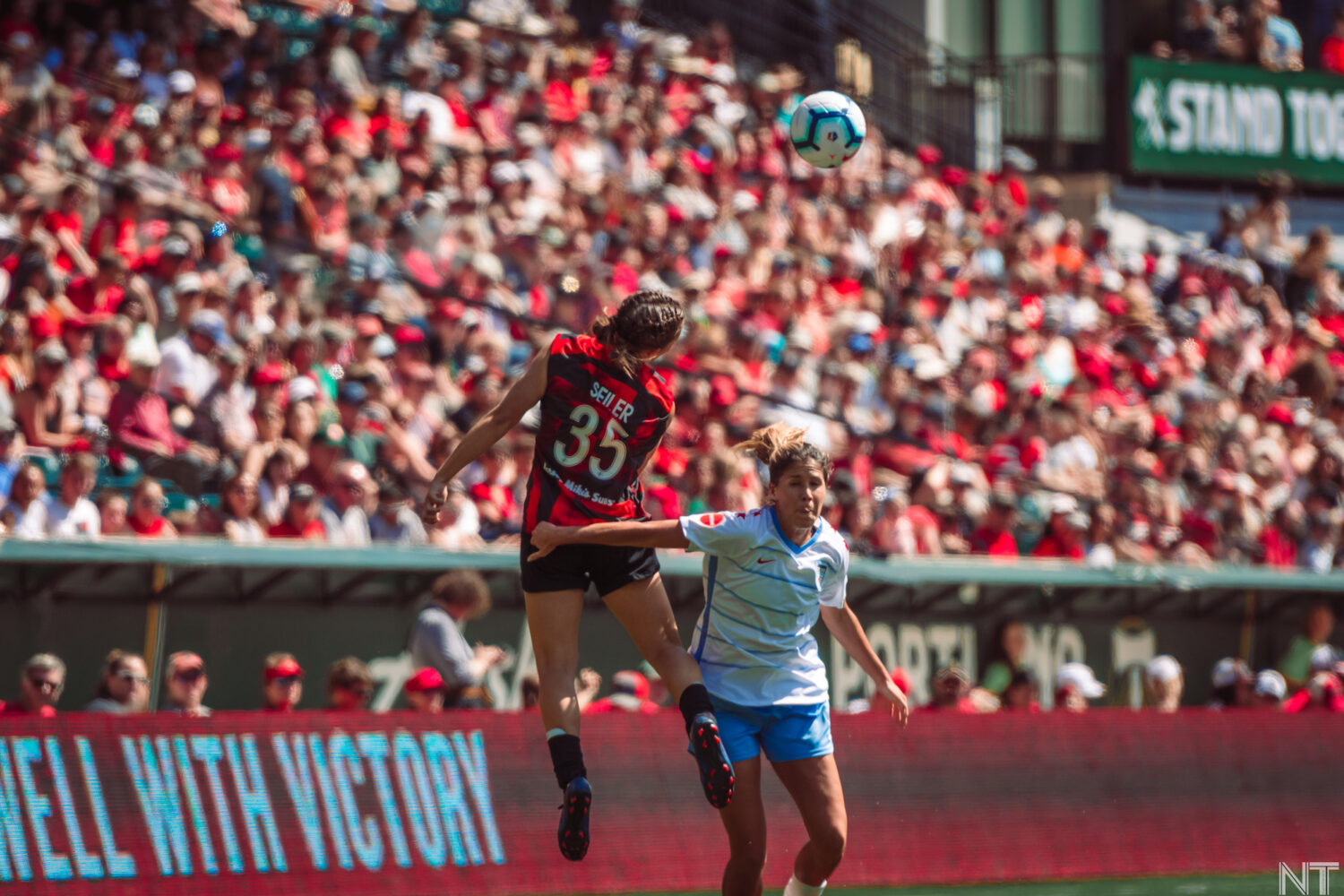
NT: Another fun question: if you could pick five tennis players for a five-a-side soccer game, who would it be, and what positions would they play?
GS: Ooh. So I would definitely would pick Serena. Position, a striker, because I feel like I would compare someone who could strike the ball well, [with her] amazing serve.
We need some defenders. Ooh, this could get kind of crazy! Obviously I would pick Kerber, because I love her as a player, but I would pick her as a midfielder, because I feel like she would cover a lot of ground. Let’s see, who else? Definitely Osaka, because I just need her calmness and composure, so I would actually pick her as a midfielder too, so that’s three. And then I would pick myself—no I’m just kidding.
NT: No, you could put yourself in this!
GS: No, no. Okay, and then, I would need a goalie. Who would you pick as a goalie? That’s kind of hard. I feel like they would all have good strengths, because they can see the ball well.
NT: Who has the quickest reflexes maybe?
GS: Yeah, what are we thinking here?
NT: Or who strikes the ball early, I guess.
GS: True. That one’s up for debate. I’m not sure who I would choose, actually. I feel like you need a good goalie for your five-a-side team. Let me tell you, it’s a game changer. I’m trying to think! You know what, I don’t know. I need to think about that one.
NT: Okay, who would you have as a defender then, because you have a striker, two midfielders—would you have a defender?
GS: I don’t know. You know what, I would maybe pick Wozniacki. Only because I feel like she is a fighter to the end of time. And she will, no matter how tired she is, she will literally go to the end and like you need that person on your five-v-five team.
NT: I like that! I see it.
GS: That’s a ballin’ five-v-five team if you ask me.
NT: Well you picked four! You need one more!
GS: Yeah, but then myself.
NT: Oh okay, you’re in this. How about you play goalkeeper?
GS: Yeah, that would be the best actually. Actually five-v-five is my favorite thing ever, so I’m really glad you asked that. We’re going to win the tennis NWSL cup!
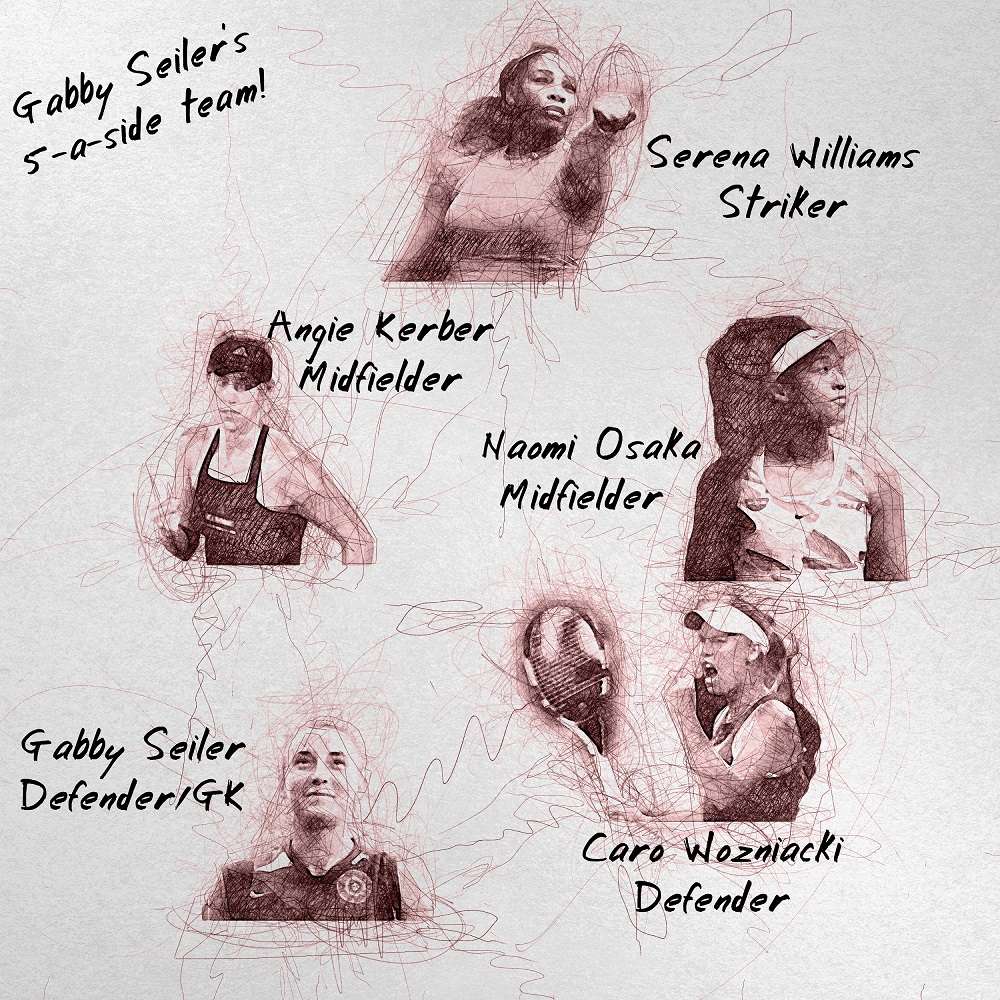
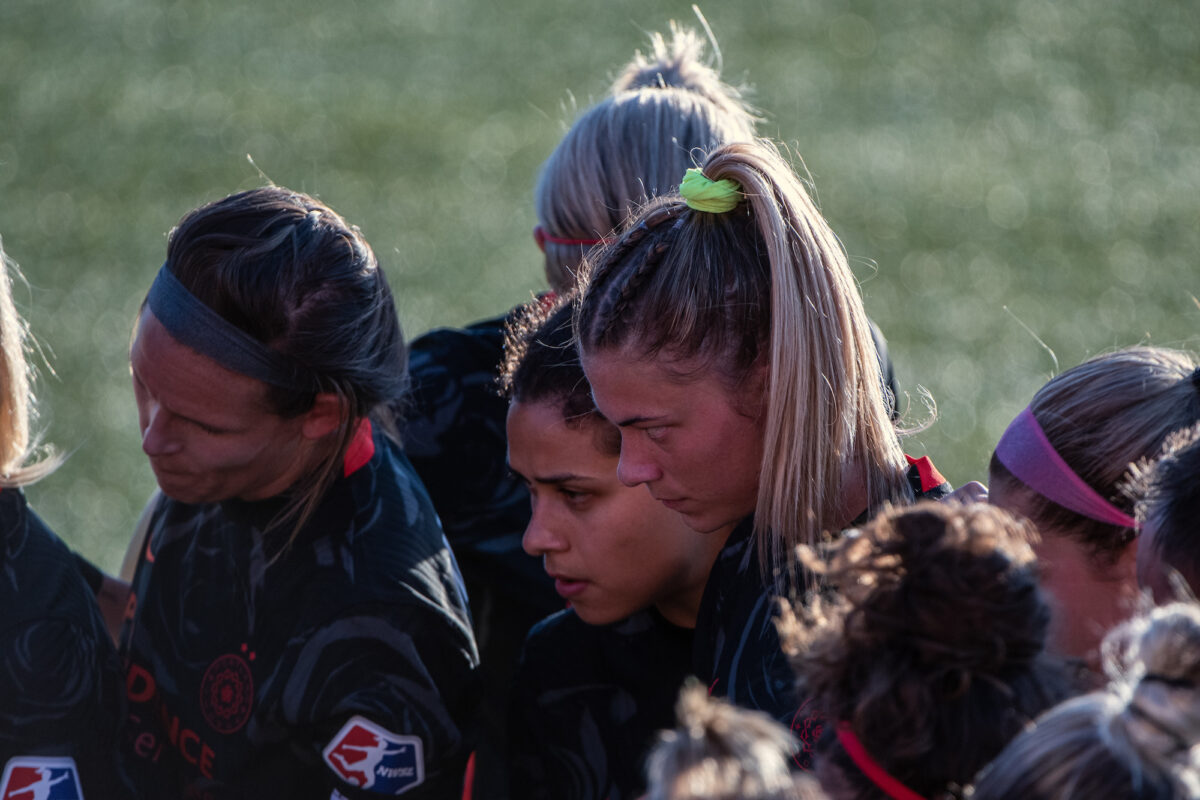
Last weekend, Thorns defender Kelli Hubly took to Twitter to voice her support for Black lives and her opposition to racism.
Black lives matter today & everyday.
I’ve been trying to find the right words to say. I’m sad to live in a world with so much hate. Where people refuse to have an open mind and refuse to educate themselves. pic.twitter.com/OUmZeJO32l
— kel (@kellihubly) August 30, 2020
She’s in the minority—most white NWSL players have not spoken up on their Black teammates’ behalf. I was curious to hear how Hubly got to this place. As much as we should all focus on listening to and elevating Black voices, I also think it’s crucial for white people to talk to each other about race, because at the end of the day, white supremacy is our problem. Our conversation has been lightly edited for length and clarity; the full audio version is available on our Patreon for supporters at the $10 level.
Katelyn Best: You said in that first tweet that you had been trying to find the right words to say. What was going through your head, and what was the thing that finally pushed you to say, “I’m going to say something even if it’s not perfect”?
Kelli Hubly: I have a lot of close people to me in my life who are Black, so I’ve had a lot of harder conversations where I’ve felt uncomfortable, they’ve felt uncomfortable, but afterwards it ended up being a great talk that I think has helped me grow, and they grow. Before Utah, I had a couple good talks, and then in Utah, I got that picture [from the tweet] and I was like, “I really want to post this.” And at that point, I know—back and forth people on Twitter, some people say, “I don’t want a white person saying stuff,” and some are like, “I would love white people to be saying stuff.” And my thought process was, I didn’t want to say something that drew too much attention to me versus the real issue, which is Black Lives Matter. So I was in a dilemma of what to say that would make it all about Black Lives Matter and not just like, an Instagram post where I look like a good person.
So I actually have a note in my phone of like, all different thoughts that came into my head, because this was over a month where I would be like, “okay, I want to say something, but it needs to be the right wording.” Finally I condensed it, and it kind of came after—our team does these talks. Like, we do them every week or so, usually on a recovery day, and we either read something, or watch something, and we come back and talk about it as a team, our coaches are there, everybody’s there, and everyone’s engaged. We’ll do a big team talk and then we’ll go into like, smaller groups. So we’ve been bringing more attention to just, everyone educating together and educating each other.
We just had one last Sunday, and it just like, really made me feel like I should post. We haven’t had games, we haven’t had really anything that we could be showing the world, like, this is how we feel. We had Utah and we kneeled, we wore the shirts, we were doing that. But we haven’t really done anything since. So it just felt like the right time for me to post, and I confronted one of my really good friends from home and asked her, “hey, how do you feel about this? Be honest with me. Do you think this is the right message getting across?” And she was like, “Kelli, I love this, this is amazing, I love seeing you use your platform.” So I ended up posting it and I got like, a lot of close friends of mine in the Black community who were like, “thank you so much, you don’t understand how much we love hearing a white person use their platform.” So it was just nice to kind of get my view on things out, because I have a lot bottled up and I haven’t known what to say or when to say it.
Take me back—you said that you guys had a bunch of conversations in Utah, and I know that some of that started even before Utah, but where were you at on these issues going into those conversations, and what did you learn?
So, yeah, we started these conversations before Utah, and I actually started the education process even before those conversations with my team. Like, watching the Meek Mill documentary or 13th before 13th kind of like, really blew up recently.
I grew up in the suburbs of Chicago, in a white area. So a lot of that was so new to me, and I had no idea. I was kind of just like, shocked that this was actually going on. And I felt a lot of shame for a very long time, because as the white person, I’m like, “how are we doing this to other people?” So yeah, a lot of shame, and I kind of just realized like, I have to turn this shame into something better and like, do better, and have conversations with people. When I went home after Utah, I had amazing conversations with my parents about it, because they also weren’t as educated, either. Like, defunding the police, what that truly means—it doesn’t [mean exactly what it sounds like], there’s deeper meaning to it. And just bringing attention to what actually has been going on, because I’ve been so sheltered.
The conversations have been great, because we’re hearing different stories from different players who have had different experiences, and we’ve been super open with each other, and no one’s really judging, everyone’s taking everybody in, and we’re growing together. I’m learning a lot. I’ve read two books about it, and it’s just very eye-opening, and it’s sad that it took me this long to know what truly has been going on.
If it’s taken me, who, I’m a pretty open person—[I’m] open to learning, I want to do what’s best, I want everything to be right in this world. After hearing and seeing, even in Utah, like, us kneeling, people writing comments, these comments are unreal to me! My bubble is so like, “Black Lives Matter!” and then I go onto Instagram or Twitter and these comments are like, insane! I’m shocked that people are still thinking this way, and it’s like, what can we do to change these people’s minds, just get them to educate themselves a little bit? It’s just crazy.
Yeah, that’s interesting, and I think that I am kind of in a similar bubble to you in that everybody I know sort of is on the same page: kneeling is good, Black lives matter, we agree something needs to happen about police brutality, and then you see people on Twitter or whatever, disagreeing with that, and it’s hard to wrap your head around.
I get furious. I’m like, I need to say something! But I can’t just be replying to all of these people!
I don’t know how much of this you saw or heard about, but during the Challenge Cup there was a lot of discourse around the kneeling. And it’s striking to me that the Thorns are the only team that every single player and every single staff member kneeled that whole time, and—I don’t want to make it about a soccer team—but to me, that seems to say something about the conversations that you had within the team, that were maybe not happening in the same way on other teams. I’m just wondering if you have any insight as to why things might have gone different for [the Thorns].
Yeah, so we, in Utah, had talked about kneeling, and basically said like, how do we feel? Because we kind of wanted it to be us unified together. And basically, we’re a very close team, like I’m sure you’ve heard through people’s interviews. We’re very close and we all really trust each other, so we can have these hard conversations, and if someone felt uncomfortable, we can have that conversation.
So we kind of all decided together. Our coaching staff has been amazing, because they’re supportive of everything we’re doing, and through this whole process they’re learning so much, because a lot of them are foreign, so this is different because they’re not even from America. They’re learning about all of our history, and they’re trying to figure out, “ok, what are we doing, what do you need us to help with?”
So basically, we made a decision, like, if we’re all going to do this, we’re all going to do it, so we decided that we all were going to kneel, and we also decided after the first game, that we were all going to do it in a line together. I feel like we’ve just been really unified, and we have a really good culture, and it’s nice to see and be a part of.
I don’t want to pry into any conversations, but was there any reluctance, were there folks on the team who were like, “ah, I don’t know, I want to respect the anthem and respect the flag,” or whatever? Was there any of that kind of conversation happening?
Yes and no. Some people, it’s family, or just having people, veterans, in their family, so I think that was the hard part, but then when we talked about it, they knew this was the best thing for us to do and they felt good about it. They were able to, say, if their family member said something to them, they were able to have that conversation and express how they were feeling. It’s just been, like, a crazy time, and people from different parts of the country, it’s interesting to see different parents’ views versus like, my parents’ views. So for the most part, I think we were all pretty much on board and felt comfortable doing that.
I don’t know if you watch the WNBA, but they’ve done a series of pretty impressive, very unified, strong statements on these issues. It’s been striking to me how much more unified and I think, frankly, more effective they’ve been as a league, than the NWSL was during the Challenge Cup. I’d love to get your thoughts on this, but I think about the whiteness of the sport of soccer. Do you think that plays a role in how some of these conversations go down?
Definitely. We’ve actually talked about this in our last talk, last week. Basically, soccer’s a super white, privileged sport. It’s expensive to play growing up. You’re traveling, you need support, you need money, basically, to play soccer at a high level. So that’s why I think you see a lot more white soccer players.
But still, it doesn’t give us an excuse for not doing as much as the WNBA. I think what they’re doing is great, and I think looking at what they’re doing, I think it’s sparked a lot of conversations within our team to see what can we do with these games coming up. We’re on CBS our first game. What can we be doing? Can the announcers be giving out facts during our game? Could we like, think of something to put on pregame instead of when the anthem’s playing, we have something else playing, like players talking about stuff going on in the world? What can we be doing to do our part? Because they’re definitely doing way more than us, and it’s been effective. There’s a picture that I saw of the players in the shirts with the seven bullet holes, and I was like, “wow, that is really powerful.” So it like, makes us want to do more when it’s our turn to be on TV.
When you say that you want to continue to support your Black friends and your Black teammates, what does that mean to you?
So, just knowing that they can come to me whenever there’s something going on, because I know times are hard and it’s frustrating, and it’s exhausting, and I just want to be able to support. Not pry, but just know that I’m always here. And to just pay attention more. I think everyone needs to pay attention more. And everyone just needs to be more kind! Like, I don’t know, the world is just crazy right now. It really bothers me, because I just see so much hate going on, and I’m just the total opposite. I have so much love to give to people.
So, support, educate, and be able to spread knowledge to people. When I went home, being able to talk to my parents more and give them a deeper meaning to things that I’m going through here. My parents are like, “oh, you’re so liberal! It must be Portland!” I don’t even think that way, I’m like, this is what’s right! This is, you know, human rights here. So just being able to support and be the best person I can be and do what I need to do to help. If it’s posting more, if it’s donating, whatever I need to be doing to make things better.
Do you have any highlights from the stuff that the team has been reading, or the stuff you guys have been listening to that you might recommend to people?
I think a great place to start is [Ijeoma Oluo’s] So You Want to Talk about Race, the book. That was the first book I read. A couple of my other teammates have read it because we were going to do a book club type thing, so a bunch of people got the book. So we’ve talked about it, and that’s a great place, I think, for people to start, because it touches on a lot of different subjects, and then basically if you want to know more about that subject then you know, like, this is what I want to zoom in on next time I read a book or something. And it gives facts, which you can’t, like—facts are facts.
It gives great stories, which are sad at times. Like she talks about being pulled over, and like, last year I got pulled over. And not once did it cross my mind that I would be scared. I’m just like, “oh my god, no, I’m caught!” My biggest thing is like, is my dad going to be mad at me? That’s what’s going through my head, but when I read this, I’m like, oh my god, people are scared for their life, where like, they’re tweeting that they got [pulled over]. Like that is so crazy to me, because that’s never once crossed my head. I’m so privileged. So that’s a great book.
13th is great because it’s just eye-opening. I really recommend the Meek Mill documentary [Free Meek], especially if you follow Meek Mill, he’s a rapper. So his story is unbelievable. I watched that and my jaw was just like, dropped. I think it’s six episodes and I watched them all in a day and I was just like, there’s no way this is real.
Then I read another book, it was a memoir of Mychal Denzel [Smith], The Invisible Man. It was interesting reading a memoir, and with voting all going on right now, it was really interesting, because in the book he talks about how when he was able to vote, him and his dad woke up at like five a.m. so that they could go wait in line for two or three hours, to make sure they could vote. And to go through like, those depths of waking up, waiting in line for two hours, to just be able to vote? I was shocked because I don’t think my parents have ever waited that long, I don’t think I would ever have to wait that long if I was at home voting—because I vote by mail-in ballot—but I was like, that’s crazy! I don’t know. It’s just really eye-opening and the memoir was really cool to read, because it’s in his shoes, and it’s just a totally different perspective, because it’s also a male perspective. It’s just been really interesting to read and just know more about.
I think the last thing I want to ask you is, how do you approach conversations with people who you feel are less aware of what’s going on, or a little bit less open to learning? Do you have a strategy that you’ve used?
Well, I haven’t really come across that many people that have not been open to it. I think, because yeah, even with my parents, if they weren’t sure about stuff, like, my mom didn’t know the term “defund the police.” And so she’s like, “Kelli, but like, we’re still going to need police officers!” And I’m like mom, that’s not the point! So like, bless her heart, she’s so cute, and then once I told her, she’s like, oh, that makes so much sense.
So I think not like, attacking people for not knowing, and not making fun of them or not thinking they’re a bad person because they didn’t know. It’s more if they’re willing to be open and learn, you just have to start wherever they’re at, and then build from there, but you have to do it in a growing way. You can’t be negative, because then they could feel bad about it, or go into a shell. We’ve talked about this on our team. And Gabby actually said, “I would give them the book So You Want to Talk about Race.” And I think that’s a great starting point for people. And she was like, there’s facts. You read those facts, like, you can’t really argue them. So I think that’s a great way to start, and then it kind of sparks the conversation.
It’s definitely hard, and you don’t want to start an argument over it. But you also need to have the conversation. So, yeah. It’s interesting, but I try to, you know, just be nice about it. Start slow and then get into it. Like I had a couple conversations with my parents, and then I told them to watch 13th. They didn’t understand like, the war on drugs and stuff. And I mean, I wouldn’t probably, either, if I didn’t watch this.

The Portland Timbers were supposed to play today, but they did something much more powerful instead.
It’s been a big day in American sports: earlier this afternoon, the Milwaukee Bucks decided they would not play their scheduled playoff game against the Orlando Magic, in protest of the police shooting of Jacob Blake in Kenosha, Wisconsin on Sunday.
“The past four months have shed a light on the ongoing racial injustices facing our African-American community,” said Bucks guard Sterling Brown, reading a statement written by the team. “Citizens around the country have used their voices and platforms to speak out against these wrongdoings. Over the last few days in our home state of Wisconsin, we have seen the horrendous video of Jacob Blake being shot in the back seven times by a police officer in Kenosha, and the additional shooting of protesters. Despite the overwhelming plea for change, there has been no action, so our focus today cannot be on basketball.”
Later, the Lakers and Trailblazers joined them in striking, as did the Milwaukee Brewers and all six WNBA teams slated to play today.
Although the first MLS game of the night, between Orlando and Nashville, went on as planned, the other MLS teams scheduled to play tonight—including the Timbers—soon announced they, too, would refuse to play.
Today—four years to the day after Colin Kaepernick first knelt for the national anthem—Black athletes once again used their platforms to center violence against Black communities by police officers and white supremacists. Teams, leagues, and sponsors have been making statements saying they support the Black Lives Matter movement since June, but have done little—if anything—to back those words up with meaningful actions. These athletes are seizing control of their platform and refusing to continue entertaining people while people who look like them are murdered with impunity.
Don’t let this moment slip by. As we’ve seen all summer, athletes can bring attention to pressing social issues, but ultimately, dismantling white supremacy is our responsibility. As Jeremy Ebobisse wrote on Twitter today, “Empty, token mea culpas are a significant part of the problem.”
https://twitter.com/kingjebo/status/1298706984242278400?s=20
Financial donations, if you can afford it, are one way to help. Jacob Blake’s family has a fundraiser here. The Milwaukee Freedom Fund, which supports protesters in Wisconsin, also accepts donations. But ultimately, we need to push for drastic policy changes. Portland mayor Ted Wheeler and the City Council can all be reached here; drop them a line and tell them you demand meaningful action on police reform.
If you’re in Oregon and you’re not registered to vote, you can do that here. There’s a mayoral run-off election this November.